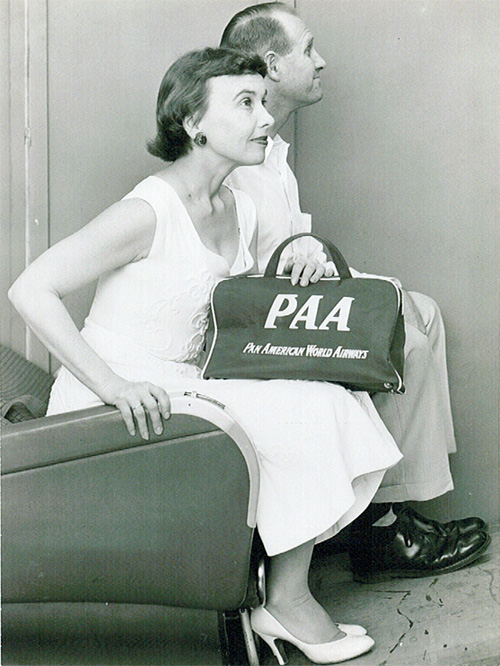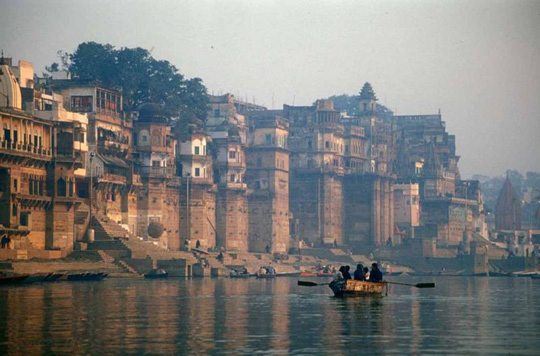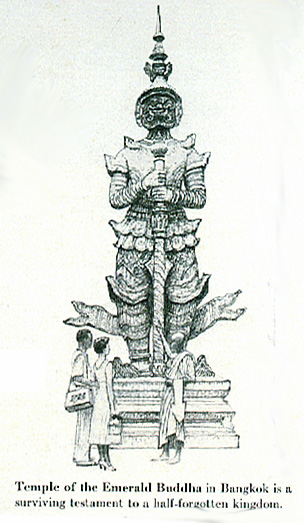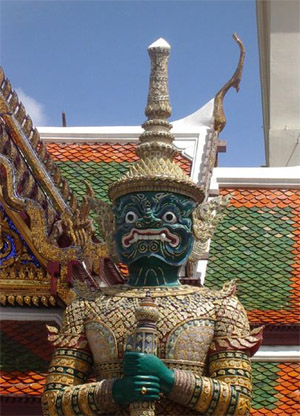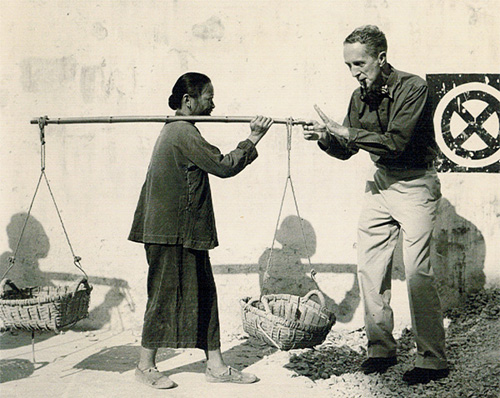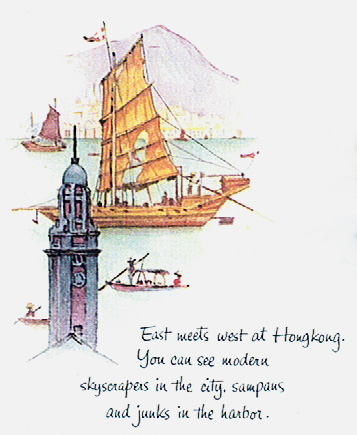Around the World with Norman Rockwell
Asia
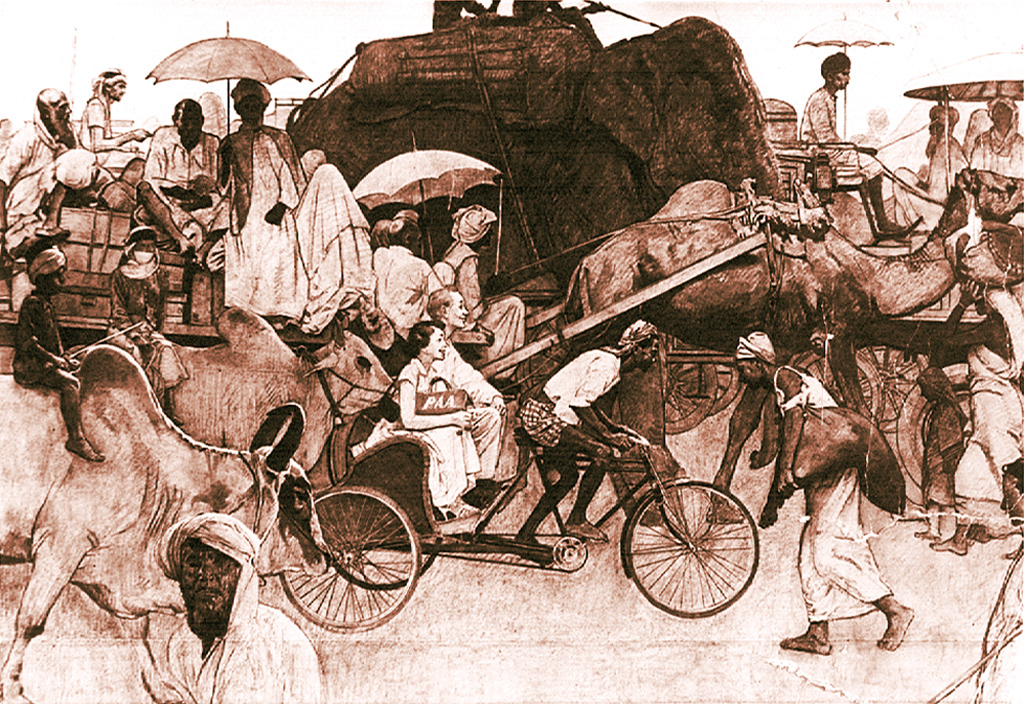
by William C. House III
Part 4.
In Asia, they went to New Delhi, Calcutta, Banares, Rangoon, Bangkok, Hong Kong and Tokyo. Only three sketches came out of it: a colorful dining scene with geisha girls in Tokyo, a small scene of the Hong Kong harbor and a small black & white picture of the Temple of the Emerald Buddha in Bangkok that gets lost below a huge color picture of a Hawaiian outrigger canoe. The sketch above by Mr. Rockwell is quite interesting, I include it on this page because it is kind of a composite picture of all of South Asia but it is actually Karachi. Back then Karachi was more Asian than Middle Eastern. Today the converse is true. There's an elephant in the picture. The only one they saw on the trip was in India. In the autobiography I quoted on the first page, he called the sketch, "a camel-elephant-water buffalo-bicycle-and-beggar-thronged street in Karachi." And in a note to my dad (on the last page) once they returned home, Norman wrote, "Wait till you see Karachi!" He obviously considered this possibly the best artwork of the trip. As far as I know he never went further with it. It never was an ad, which is a shame because I think it would have been great. My dad wrote this on the back of a picture of he and I posing* for Rockwell, regarding this scene: "Pan Am didn't buy the idea because of the times-- India and Pakistan were at war and white supremacy was an issue. The whole picture was gray and sepia tones except for the white tourists." (Note: I only have a b&w copy. I gave it a sepia tone look with Photoshop. Also, I think British rule was still fresh in the minds of Pakistanis and Indians, that's why the term "white supremacy" was used.) The two tourists in the bicycle taxi are my parents. Our whole family traveled twice to see Norman Rockwell. We visited him at his Stockbridge Mass. studio and we went down to Florida for some Panagra (Pan American-Grace Airways) ads and to sit for pictures for the Pan Am around-the-world layouts. That's my parents to the right sitting for the scene on top. They look very Rockwellian, don't you think? My dad also posed for several Hawaii shots that you'll see on the next page. I even got to pose, which you'll see on the last page. The story continues in Calcutta: BILL HOUSE: "Our flight to Calcutta was quite exciting especially when we passed the Taj Mahal about 100 miles south of New Delhi. The captain pointed it out to us on the left side of our ship and everybody crammed the windows, looking out. We had a beautiful view of the Taj Mahal right on the river. The Taj is a beautiful building, dome shaped, ivory carved. You could almost see the ivory carvings from the plane. It's about a four hour taxi ride from New Delhi but well worth the effort. The Taj is one of the seven wonders of the world. It sits on the river and of course, everyone says it must be seen by moonlight. After leaving Karachi and the Taj, you fly across India, and at this time of the year it is a wonderful brilliant green color. You see the rice paddies down below, the rivers winding around and the little villages. It has the feeling of a never, never land. We landed in Calcutta at the Dum Dum Airport [Now called the Netaji Subhash Chandra Bose International Airport]. Here again we were met by Pan American personnel. We were very fortunate to hit India just after the monsoon season. Everything was so beautiful, fresh and green, which was quite a difference from the last time I was here. It was right before the rains when it is hot and very dry. We were very surprised to see how wonderful the climate can be. We drove about a half an hour to the wonderful Grand Hotel which is the old meeting place of the British and Indian Society. The rooms were all tremendous and air conditioned. It made you feel as if you were in a palace. Besides a bedroom, you have a little dressing room and a tile bath. When we arrived, we had all the fifteen pieces of luggage, and we again arrived upstairs with fifteen boys, naturally tipping them all. When you tip them here in India, the exchange rate is about 5 rupees to the dollar. The rupee being about twenty cents will buy in India the same as a dollar in the States." [The rupee is worth about 45 cents now.] |
|
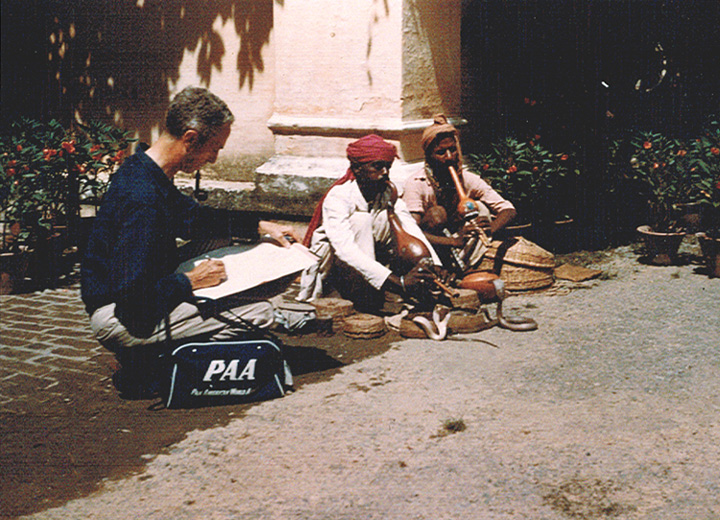 |
"The trouble that most Americans have when they go to India is that the Indians are past masters at the art of extracting a tip from a tourist. They look at you with this forlorn look in their eye as if they didn't have a piece of bread. By the time you look them over, you give them too much according to their standards. We flew Indian Airlines to Banares [also called Varanasi] which is the Holy City of the Hindus. It was a 2 ½ hour flight and when we arrived, we went straight to the Clarks Hotel. This hotel skirts over a large area. Porches run the length of the hotel, two stories high. When we arrived we saw a snake charmer outside our window again, the same as we did when we were in Karachi. We posed the snake charmers with the cobras and the other snakes, around with some children. The next morning we went down to the Ganges which is where all the pilgrims come from miles around to wash their sins away. It is a fast flowing river and very muddy and dirty. On Sunday, one of their holy days, we went down on the steps where all the people were taking their baths. They usually wear a thin garment. Along the Ganges there are many steps and temples which were erected to the great chief God, Shiva. You get the feeling that if this were back in America, the Women's Auxiliary and the Alta Guild would go out and clean up this place of worship because I should think that the great God would be a little offended by the condition it is in. The pious men, women and children practically disrobe as they stand in the dirty water, bathing their sins away and brushing their teeth." |
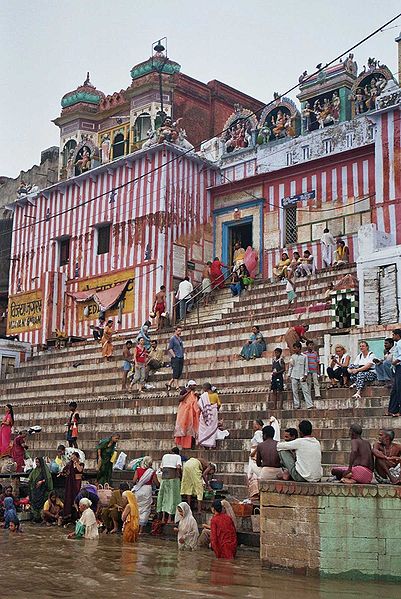 People performing Hindu ceremony at one of the ghats of Varanasi. |
"We rented a boat there and a guide took us out on the Ganges which was quite an adventure because the Ganges is very swift and it is a problem to keep from barging into worshippers. While going down the Ganges we came upon the smoking ghats. This is where the bodies of the Hindus are cremated. Their dead are taken down along the river publicly, and then the bodies thrown on piles of wood where they are burned on top of the walls, and their ashes pushed into the river. On the way from the airport, we passed a number of bodies on carts. Women are wrapped in some kind of red cloth and the men are wrapped in black. We visited various temples including the Temple of Love. The other two gentlemen [Blackie and Norman] here advised me not to describe too much in detail. This temple might shock the average American, but these people are very free in their ideas about life in general and particularly this part of life. We got quite a kick out of it." Editor: Funny stuff. I don't know what temple he's talking about. Could be Kashi Vishwanath dedicated to Shiva but I'm guessing this temple must be dedicated to a goddess, so it could be the Durga Mandir. Of course, the embrace of gods and goddesses is meant to show the shakti—the flow of Divine feminine and masculine energies.
|
"Like all holy cities, they have a few beggars around throughout the town. We also saw the fakirs. We had one of them give us a demonstration. He sat on a bed of thorns, and being quite thin, it looked like the thorns were going right through him. There were a few men sitting on streets who were lepers. Naturally, we were told to stay away from them and not to touch them for fear we would catch leprosy.
The Ganges river rises during the rainy season and floods the temples. There are markers on the wall showing how far up the river has risen, reaching as high as 25 feet. In fact, some of the temples which at one time were out of the water are now almost completely buried. All you see is the dome sticking out of the water.
In downtown Banares tourists can pick up quite cheaply many fine pieces of material, such as madras cloth or silk saris which the Indian women wear. Many women tourists are taking saris home and making dresses and blouses, etc."
ROCKWELL: "The Clarks Hotel was very British, must have been just the way it was during the time the British controlled the country, clean, neat, and I am sure any American would feel at home there. I wouldn't say the same thing about the native quarter. It was very fascinating, in fact, it seems to me, whenever the country is poor or the natives live in their original state, it is much more picturesque and interesting."
BILL HOUSE: "Going back to the airport we saw our first elephant, our first and only elephant on the whole trip. There were two boys riding it, and we had them stop and pose for several pictures. We returned from Banares to Calcutta, and the next day we ventured on to Rangoon which is about a two or three hour flight from Calcutta. Rangoon, Burma [Myanmar] is a picturesque little town, you begin seeing a lot of priests in their colorful orange robes, carrying big red parasols. The two large temples are the Sule Pagoda and Shwedagon Pagoda. Both of these have large gold spires. They get this way because the worshippers buy gold leaf and rub them on to the domes. At the top, however, there is a six foot section which is made of solid gold bricks. When visiting these temples you have to take your shoes off and walk up endless steps, dodging puddles of water, and by the time you return to the street your socks are quite filthy. These temples are so ornate and beautiful that they are really hard to describe. It must have taken years and years to build. On the way up to these temples you find shops on both sides of the steps where you can buy anything from combs to little worship items to take on up to the temple.
The Burmese women are quite pretty and petite, and they have very fine features. One of the Pan Am office girls helped us by posing by a temple wearing a longyi which is their native dress. You will also find the women squatting instead of sitting while smoking tremendous cigars. One interesting thing we saw was a woman nursing a baby and at the same time smoking one of these huge cigars."
ROCKWELL: "One of the things that impressed me coming from India to Burma was the change in the status of women. The women in India are kept at home and are not equal to the men, and the few you do see on the streets are very timid, the taking of photographs is very much resented. When you get to Burma this all changes. The women work alongside the men, and the men seem to respect them. The family life is right out on the streets.You can see the children, mother and father walking together, and it seems very pleasant. In India there was sort of a threat in the air. The streets are crowded and you get the feeling that the people are very excitable and there could be a sort of a mob effect. In Burma, the people are smiling more and seem happier. They are not having an easy time. The Pan American representative told us, he respects them a great deal because although they are having a tough time governing themselves (after the many, many years of being governed by other people), nevertheless, they are trying valiantly to run their own government, the best they can. If they are going to make mistakes, they are going to make them. You feel that the people of this country have a great deal of hope.
The large temple which is called Shwedagon is spectacular. The spires can be seen from all over the city. There are many steps leading up to the temple. Surrounding the base of the shrine, there are many similar shrines, each one has its own little god or Buddha inside. It was told to me, that years ago, if someone died, his heirs would build a little shrine at the base of the big temple. These small temples are beautifully built. They all seem to be replicas of the big temple. Each family as they go to pray, would stop in front of a smaller temple. In front of these temples is a small opening or gate. In it you can see the Buddha. The people bring flowers. They take water which they very tenderly throw on the Buddha, either to cleanse it or keep it cool. They are very devout people and so it seems to mean a very great deal to them. When we descended the steps we passed bazaars that sell all sorts of things that they use in their worship.
Like all of Asia it seems to be overpopulated. When we flew into Rangoon, we noticed the tremendous rice fields. There's more rice produced here than any other country, more, by far, than Japan. You see all the fields flooded, the beautiful green rice growing and plenty of water buffalo wading around through the fields. Water buffalo are tremendous beasts and it seems almost impossible that little children could get up on them. They must learn at a very early age because it looks as though some of them are not more than two years old riding and steering these behemoths."
"We continued on our round-the-world flight to Bangkok. Here again, coming into Bangkok, we noticed the tremendous rice fields. The life in Bangkok is centered around the little canals and rivers. All the shops are on stilts with porches. People carry on their trading from boats, selling everything from bananas to cloth. Early morning is the best time to strike out and take a tour in a motor launch because the canals are alive with activity. Some parts of the canals are very much like a jungle, overgrown with many banana trees, and royal palms. On this tour through the canals we also saw a lot of ship builders and, by the way, most of these boats are called sampans. The main river running through Bangkok is the Menam River [Now called the Chao Phraya River]. Here again, of course, the great attraction for the tourist and foreigners is to go to the Temple of the Emerald Buddha [Wat Phra Kaew]. It is stupefying to see the size of these temples. They sit upon about ten or twelve acres of land. These gorgeous temples have taken centuries to build. They are built on the same plan of those in Rangoon. However, here, shiny mosaic tiles are included in the design. We went into the temple yard. As you enter, your attention drifts to the great, enormous, thirty foot statues, as they peer down at you. They are all guardians of the temple. They are meant to frighten away evil spirits and anybody who would molest the temples. I was fascinated by the color they have on them. The faces are generally blue, very hideous with great, staring eyes; decked out with armor and spears. You go on up to the great temple which is the most sacred of all the temples in Bangkok. You are not allowed to bring a camera into the Temple of the Emeral Buddha. There are many people in postures of prayer in a room that I think is the most beautiful I have ever seen in my life. The Emerald Buddha is a very small buddha. It is up on a very high altar, brilliantly lighted. On the walls are marvelous paintings that are kept in beautiful condition. The floor is of magnificent mosaic and the whole thing is absolutely fabulous. I understand this has never been photographed. Blackie started in with his camera, but they made him put it away. It was here in Bangkok that we got the services of a young princess. She put on the costumes of the dancers and Bill will describe that to you." BILL HOUSE: "Girls of the upper class learn how to do these temple dances. The princess that helped us out brought her sister along to act out the male part. They had a dancing teacher along and she put them through their paces, giving us various poses to photograph. The headdress looks just like one of their temples with spires and is quite heavy. The costumes are rich in values of gold, red and blue. The dance consists of moving arms, swaying, advancing and retreating with gliding motions while the fingers are kept bent back to the uttermost. For the shoppers here in Thailand, there's a wonderful shop called Thai Silk. It is a place owned by Jim Thompson. There was an article in Life magazine describing the colorful silks that he produces. He started out as an architect years ago and developed into this line of work. He has his own silk mills, mixes his own dyes and designs fabrics. A woman goes crazy in this place, what with the amount of brilliantly colored silks. We all bought many ties and silk scarves for our wives." [In 1967, Jim Thompson vanished while walking alone in Malaysia’s Cameron Highlands. He was never heard from again. Source: Princetonís Man Who Knew Too Much. Editor] ROCKWELL: "Jim Thompson invited us over for dinner at his house, he lives in a very beautiful native house [His house is now a museum]. He has a very interesting history himself. As Bill said, he started from Philadelphia as an architect and comes from a very fine family there. He was in the OSS and was parachuted into Bangkok, presumably to handle resistance there when the Japanese had control. The war ended right after he parachuted in, so he was the man who received the surrender of the Japanese. He has lived there ever since and he loves it there. He has built a big industry and is a sort of soldier of fortune, the kind Kipling wrote about. It was very interesting to visit his house because he has one of the finest collections of Burmese art, paintings and sculpture. In all of these countries, their art goes back long before Columbus came to America and it is very fascinating to see. One of their big problems, is their strange allegiance between the old traditions and the new regime, and the new life and government they want to set up. We took a drive out into the country to see some of the farms. Right away you start seeing rice fields, and the farmers, here again, live with their houses on stilts with planks going from the roads right up to the front door. Or they are right on the canal and the only way to get to their house is by boat. Like most of the places where we have been, you could not get the true picture of the place unless you got out into the country and saw how the farmers live. They wore a different dress which is much more colorful. We got a big bang out of one of these little launches when we took this tour down river. There was a fellow steering the boat and then, about not more than 10 feet in back of him, there was a fellow operating the engines and he had signals, bell signals, for everything—one bell, back up—two bells, go ahead and about every five minutes Blackie was stopping him to take a picture. I never heard so much bell ringing in all my life. Each family has their own little shrine stuck on a pole in their yard. About the size of a bird house, these shrines resemble the bigger temples. Inside you will find little gods and other figures. One of these little figures got knocked over and we were told to stand it up, but then we were told it was evil, or a sin for an outsider to touch the temple at all, so we decided to leave well enough alone. " BILL HOUSE: "The Emerald Buddha is quite unusual in that the image has been cut out of a single piece of clear translucent jade and got its name because of a large emerald set in its forehead." |
|
"We went to see the royal barges which were very long boats called supannahong royal barges. These are used for state ceremonies and by royal princes on the river [Royal Barge Procession]. The King sits on a throne which is set on a platform a little aft of amidships. The boat was narrow, about 125 to 200 feet long. The front of the boat is gold and shaped like a serpent's head. There are hideous guards mounted on the front of the escort boats and a hole is dead center where they fired the cannon. The guards have blue faces, gilded claws and wings protruding from their backs. You will see in the shops many beautiful pieces of jade jewelry. The jade is brought down form communist China. It is cut and set in bracelets, rings, etc. However, I will caution anyone buying these things because it is difficult to bring them into the U.S., in fact, it is impossible because jade is only known to come from communist China. Even though I have mentioned that the city is made up of canals and rivers, there is a section of the town built up with modern buildings and streets. Our hotel, the Park was on dry land and there were five or six individual buildings. Each building had three or four rooms. The mosquitoes are quite bad down here. This is a nice hotel in that we had air conditioning. All through the warm climates we found air conditioned hotels. At 2:30 am we boarded the round-the-world plane for Hong Kong. Coming into Hong Kong is a beautiful sight. The bay is completely surrounded by mountains—the city is situated at the base of a mountainous island. The mainland, Kowloon, is across the bay. Because of the mountains, it is a difficult airport. However, Pan Am pilots fly in and out of here frequently, so they are thoroughly familiar with every condition. This is a wonderful city after coming from the Middle East, where it isn't particularly clean, where you have to watch your food, diet and not drink the water. Hong Kong, being run by the British, is a beautiful city, very clean. After walking around through town, you realize the British are running the show, but you never seem to see them. They are sort of behind the scenes. The police are native Chinese wearing British uniforms. To start describing Hong Kong—this is where you see attractive women wearing split skirts. The split will range anywhere from the knee on up. As Mr. Rockwell says, there should be zippers on these skirts so they can, depending upon how they feel in the morning, put it at any length they want. Most of the dresses are made of silk with straight lines, no belts and with high collars. The split skirt was a topic of conversation among the men and the women we met. (I get the feeling the trio brought up the subject first. Editor) In the harbor, which is one of the most fascinating in the world, are these marvelous junks. To me, they look like the ships that Columbus sailed, only on a smaller scale. They have large sterns, built up quite high. Attached to the masts are the most disreputable, picturesque sails I think I have ever seen, patched with all sorts of color and of course, it makes them ideal from a picture standpoint. I understand that although they look very clumsy, they really are quite maneuverable." This ends the comments by my father and Norman.
|
|
Hong Kong Harbor
The Rockwell mirror effect. Editor |
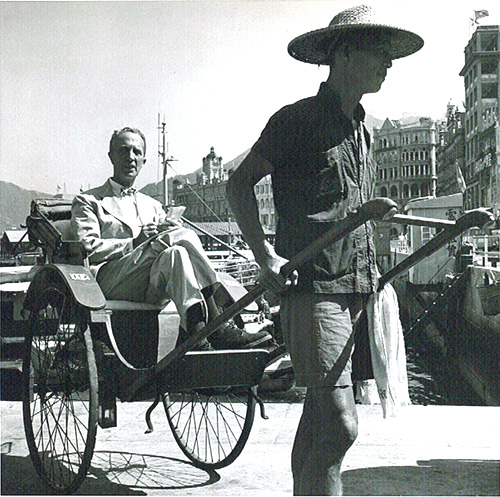 |
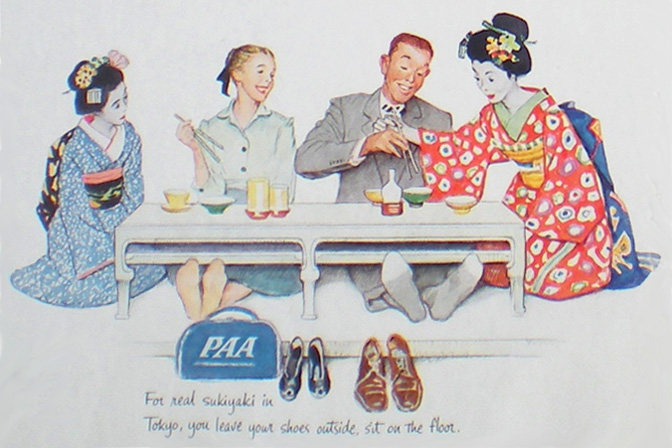
The final stop on the Asian leg of the tour, and the third and final scene for all of Asia.
It actually appears twice. A small B&W version is under the outrigger canoe on the next page.
© William C. House
Next, Part Four: Hawaii
Return to Page One
Main Page: Reverse Spins
